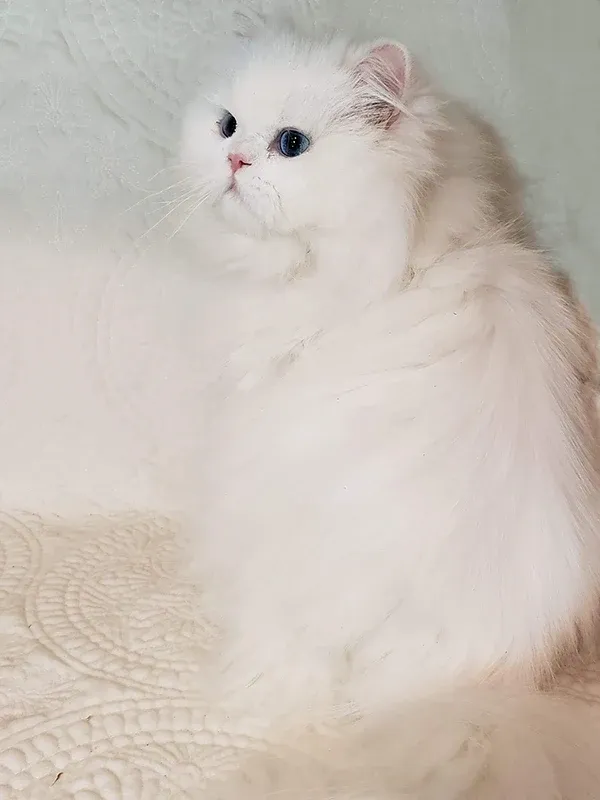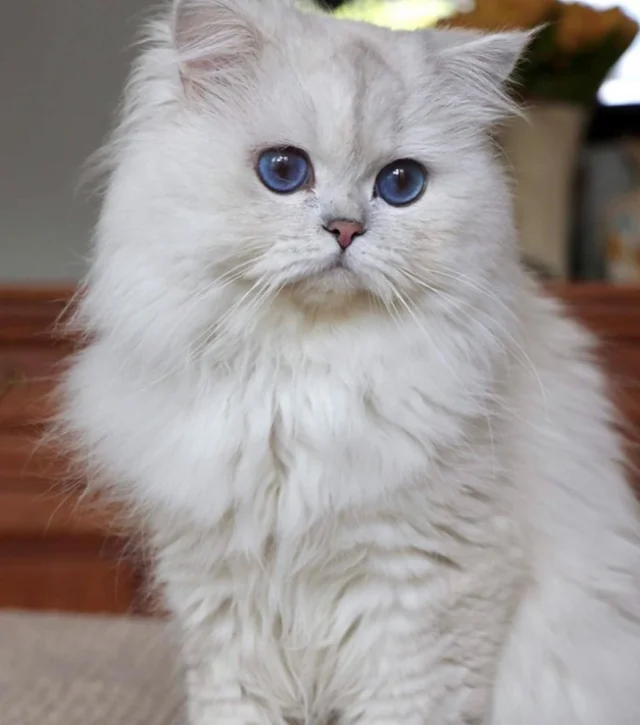Persian
The Persian cat, renowned for its striking appearance, is one of the most popular and recognizable cat breeds in the world. Distinguished by an exceptionally long and luxurious coat, Persians boast an inherent elegance. Their flat faces, characterized by short muzzles and large, expressive eyes, contribute significantly to their unique allure. The round, compact body structure and short legs provide a distinct silhouette that captivates cat enthusiasts and newcomers alike.

Originating in the late 1800s, Persian cats have gained immense popularity in families and feline circles for their gentle nature and calm demeanor. Their affectionate personalities make them ideal companions for various living situations, including apartments and houses alike. They often form strong bonds with their owners, showcasing a loving temperament that appeals to many cat lovers.
However, owning a Persian cat entails specific responsibilities, especially regarding grooming needs. Due to their long, thick fur, regular grooming is crucial to prevent matting and maintain a healthy coat. Daily brushing is recommended to remove loose hair and debris, ensuring that the cat’s skin remains healthy. Furthermore, their somewhat unique facial structure necessitates regular cleaning around the eyes to prevent tear stains, which can detract from their overall appearance.
In addition to grooming, prospective Persian cat owners should be mindful of their playful yet serene tendencies. These cats, while often content to lounge around the house, enjoy interactive play sessions and mental stimulation. Understanding and embracing the characteristics of the Persian breed will enhance the experience of owning such an enchanting feline companion.

Personality
Persian cats are renowned for their distinct and charming personality traits that make them beloved companions in households around the world. One of the most notable characteristics of Persian cats is their gentle and affectionate demeanor. These cats tend to establish strong bonds with their owners, showcasing a loving nature that thrives on companionship. Persian cats often exhibit a calm and easygoing temperament, making them well-suited for both relaxed living environments and families.
In terms of behavior patterns, Persian cats are generally less prone to hyperactivity compared to some other breeds, which aligns with their preference for a serene environment. They enjoy basking in the sun and can often be found lounging comfortably in their favorite spots. Despite their laid-back nature, Persian cats do have playful moments; they appreciate engaging with toys that stimulate their curious minds while also allowing them to showcase their intelligence. Interactive play can be beneficial in building a strong bond between the cat and its owner.
While Persian cats are inherently sociable creatures, it is essential for prospective owners to understand their social dynamics. Introducing a Persian cat into a household requires a gentle approach, as these cats can be sensitive to changes in their environment. Owners are encouraged to devote time to nurturing their relationship with their Persian cat. This can be achieved through regular grooming sessions, as Persian cats often enjoy being brushed, which not only maintains their luxurious fur but also serves as a bonding activity.
In conclusion, Persian cats exhibit a unique blend of affection, calmness, and playfulness, making them ideal companions. Understanding their personality traits and social preferences can lead to a fulfilling relationship, ensuring that these exquisite felines thrive in their homes.
Origins
The Persian cat, with its luxurious fur and distinctively flat face, boasts an intriguing lineage that can be traced back to ancient Persia, which corresponds to modern-day Iran. Historical accounts suggest that these felines were domesticated around 1600 BC, becoming cherished companions among nobility. The breed is believed to have developed from local cats that displayed long, flowing fur, likely attributed to the region’s diverse climate and genetic factors influencing feline coats.

The 17th century marked a pivotal moment for the Persian cat when they were introduced to Europe. Notably, explorers and traders returned from their travels with these exquisite felines, sparking immediate interest among cat enthusiasts. The breed quickly garnered admiration due to its striking appearance and gentle temperament. In England, the Persian cat was officially recognized by cat fanciers and started to gain popularity at cat shows. This era also paved the way for systematic breeding practices, which focused on enhancing specific traits such as coat color, body structure, and personality.
Over the years, the Persian cat’s allure transcended geographical boundaries, making its way to North America in the late 19th century. Here, they captured the fancy of both breeders and the public, resulting in the establishment of breed standards by cat registries. The breed’s plush coat and friendly demeanor were equally appealing; thus, Persians became one of the most popular cat breeds. Cultural significance became intertwined with their presence; they were often featured in art and literature, symbolizing grace and luxury. The evolution of the Persian cat exemplifies the intersection of human appreciation for beauty and the natural adaptations of a breed that continues to enchant enthusiasts worldwide. In conclusion, the historical journey of the Persian cat illustrates not only its origins but also the ways in which this breed has shaped and been shaped by human culture.
Care of the Persian cat
Caring for a Persian cat requires dedication and a thorough understanding of their unique needs, particularly due to their luxurious long fur. Grooming is a fundamental aspect of maintaining their health and appearance. Regular brushing, ideally on a daily basis, is essential to prevent matting and tangles in their coat. Utilize a wide-toothed comb or a slicker brush specifically designed for long-haired breeds to effectively remove loose fur and minimize shedding. Additionally, a bath every few months can help maintain the cleanliness and luster of their coat. Use gentle, cat-specific shampoo to avoid skin irritation.
Nutrition also plays a crucial role in the overall health of Persian cats. High-quality cat food that meets their specific dietary requirements is vital for their well-being. Look for diets that are rich in protein and free of fillers. Ensure that fresh water is always accessible, as proper hydration is key to preventing urinary tract issues, which Persians are prone to. Regular vet check-ups are recommended to monitor their health and to address any potential concerns early.
Exercise is another important factor for the maintenance of a Persian cat. Though they are known for their calm and laid-back demeanor, they benefit from daily playtime to stimulate their minds and encourage a healthy weight. Engaging them with toys or interactive play sessions can help keep them active and content. Additionally, creating an enriching environment is essential for their mental well-being. Provide a variety of scratching posts, climbing trees, and cozy hideaways to satisfy their natural instincts.
Caring for a Persian cat involves a commitment to their grooming, nutrition, health care, and exercise. By understanding their needs and providing the appropriate care, owners can ensure a happy and healthy life for their cherished feline companions.
Health
The Persian cat is a luxurious breed known for its long, silky coat and sweet temperament. However, they are prone to health issues like respiratory problems due to their flat faces (brachycephalic), polycystic kidney disease (PKD), and dental issues. Regular grooming, a balanced diet, and routine vet checkups are essential to maintain their well-being. Learn how to keep your Persian cat healthy and happy!
Nutrition
Persian cats need a high-quality diet rich in protein, healthy fats, and essential nutrients to maintain their luxurious coat and overall health. Opt for specially formulated Persian cat food that supports digestion, prevents hairballs, and promotes a shiny coat. Wet food and fresh water are crucial for hydration, while omega fatty acids help reduce shedding. Avoid fillers and artificial additives for optimal feline wellness.
Cleanliness
Persian cats require daily grooming to maintain their luxurious, long coats. Their thick fur is prone to matting, so regular brushing is essential. Frequent eye cleaning is also necessary due to tear staining. Keeping their litter box clean is crucial, as Persians are known for their preference for cleanliness. Proper hygiene ensures a healthy and happy Persian cat.
Best cat breeds for kids
Persian cats are one of the best cat breeds for kids due to their gentle, affectionate nature and calm temperament. Known for their luxurious long fur and sweet personalities, Persians enjoy cuddles and relaxed playtime, making them ideal companions for children. Their easygoing demeanor and loving disposition ensure a strong bond with young pet owners. Regular grooming is required to maintain their beautiful coat, but their patience and friendliness make them a perfect family pet.
People who have seen this breed have also visited…
In this section you can find completely detailed information about the breed of your cat.
